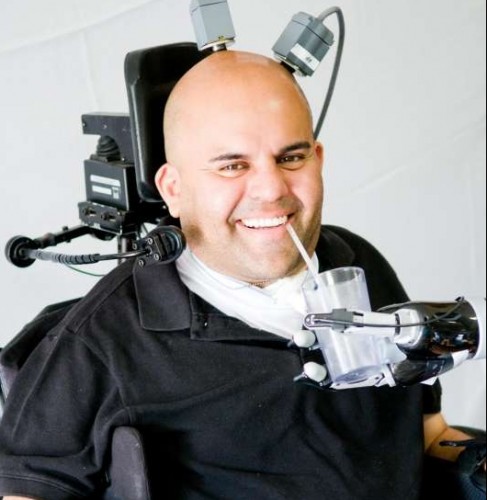
In a pioneering feat, a team of US scientists has developed a novel system that allows a patient to control the movement of his robotic arm with his intention.
The researchers from California Institute of Technology (Caltech) and Keck Medicine of University of Southern California surgically implanted a chip in that portion of the brain of a paralysed patient that doesn’t directly control movement but rather the intent to move.
The patient can now perform a fluid hand-shaking gesture and even play “rock, paper, scissors” using a separate robotic arm.
This is how it works.
When you move your arm, you really do not think about which muscles to activate and the details of the movement – such as lift the arm, extend the arm, grasp the cup, close the hand around the cup and so on.
Instead, you think about the goal of the movement.
“So we were successfully able to decode these actual intents by asking the subject to simply imagine the movement as a whole, rather than breaking it down into a myriad components,” explained principal investigator Richard Andersen, the James G. Boswell professor of neuroscience at Caltech.
In the brain, the signal moves up to a high-level cognitive area known as the posterior parietal cortex (PPC).
Here, the initial intent to make a movement is formed.
In the clinical trial, the team implanted a pair of small electrode arrays in two parts of the PPC of the quadriplegic patient.
Each array contains 96 active electrodes that, in turn, each record the activity of a single neuron in the PPC.
The arrays were connected by a cable to a system of computers that processed the signals, decoded the intent of the subject, and controlled output devices that included a computer cursor and a robotic arm developed by collaborators at Johns Hopkins University.
After recovering from the surgery, the patient was trained to control the computer cursor and the robotic arm with his mind.
Once training was complete, the researchers saw just what they were hoping for: intuitive movement of the robotic arm.
“The most exciting moment of the trial was when the participant first moved the robotic limb with his thoughts. He had been paralyzed for over 10 years,” informed Andersen.
This was the first time since his injury that he could move a limb and reach out to someone.
“It was a big surprise that the patient was able to control the limb on day one — the very first day he tried. This attests to how intuitive the control is when using PPC activity,” the authors noted.
The patient Erik G. Sorto was thrilled with the quick results.
“I was surprised at how easy it was. I remember just having this out-of-body experience, and I wanted to just run around and high-five everybody,” said Sorto.
This better understanding of the PPC will help the researchers improve neuroprosthetic devices of the future.
They hope that neuroprosthetics will eventually enable patients to perform more practical tasks that will allow them to regain some of their independence.
The results of this promising trial have been published in the journal Science.